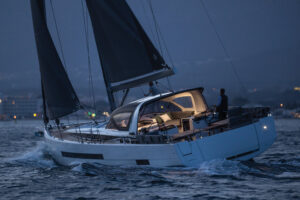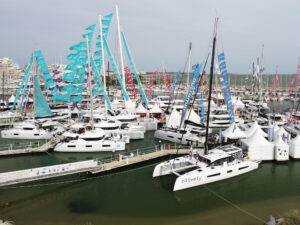Pinning a tag on William H. (Bill) Stevens isn’t easy. As we watched him approach us on the dock in Miami last February, his lopsided swagger made Melissa Dobson, my wife, think of John Wayne. So did some of his mannerisms of speech. She was close. The clincher, though, was the eye patch: We settled on Rooster Cockburn, the character Wayne played in True Grit.
The eye patch probably had something to do with the lopsidedness and had everything to do with Bill Stevens’ long life on and about the water, which began when he was in his teens and his father managed construction projects in the U.S. Virgin Islands. The family lived on St. Croix, and young Bill taught himself to hunt underwater, freediving to well over a hundred feet. “Too much fun in the sun,” as Stevens puts it, resulted in the loss of his left eye, in October last year, to basal-cell carcinoma. That news gave pause to all of us who know him and have been similarly exposed.
After school and a stint in the U.S. Navy in the 1960s, Bill found himself cruising the West Indies with his then wife, Barbara, in Beloved Vagabond, an English Hillyard. To make a little money, they started taking people out on charter. He quickly expanded his activities, acting as agent for Beloved Vagabond and Gordon Stout’s 38-foot Stonington motorsailer, and in the embryonic charter industry, Stevens Yachts was soon a motive force, and as such not always a welcome one.
The yacht-charter club in the eastern Caribbean of the 1970s was made up largely of British expats and their Colonial cousins. Their founding member was Commander V.E.B. Nicholson, who’d started chartering in the early 1950s out of English Harbour, Antigua, and was generally regarded as the pooh-bah of the business. Stevens is very American, and not Graham Greene’s quiet one; his manner often pained his reserved Brit contemporaries. He was, though, a man of his word, and no matter how outrageous that word may have sounded at the time, he always did what he said he would do.
One of his early infractions was to initiate the “all-inclusive” charter rate.
“Back in those days, food was extra, liquor was extra, docking fees, and on and on,” Stevens says about the standard charter contract. “The poor skipper had to be a CPA. I looked at that and said, ‘This is as dumb as hell.’ And the commission was only paid on the base boat. The Nicholsons were the ones who’d established that.
“I said, ‘To hell with that, we’re going to pay a 15-percent commission on the total package–food, booze, fuel, everything,'” says Stevens. “Heck, gin was about $1.75 a fifth.
“I got a message from Nicholson: ‘Who did I think I was? Change your system.’ Well, Beloved Vagabond and Gordon Stout both did 32 weeks of charter in the first year, and that was the end of the argument.”
All-inclusive charter rates soon became the norm, at least in the eastern Caribbean and on the boats that were booked through Stevens Yachts and the ever-growing competition. When Stevens made me a charter skipper in 1972, I was relieved to be able to wish my charterers farewell not with a shakedown for the embarrassing quantities of beverages people can consume while on vacation but with a smile and a handshake.
Stevens also introduced major changes in the bareboat charter business by building standardized fleets. In 1970, he worked out a deal with Pearson Yachts to build boats to his specifications for the Stevens Yachts bareboat operation in Grenada. When Pearson put back the delivery date and Stevens found out it was because they were building boats for his competitor, Jack Van Ost’s Caribbean Sailing Yachts, Stevens canceled and took his ideas to Charlie Morgan. He brought along Charlie Cary, the founder of The Moorings, whose nascent B.V.I.-based business he didn’t consider a threat to Stevens Yachts. The outcome was the Morgan Out Island 41, which pleased few old-school yachtsmen with its looks but set the standard for a generation of cruising boats when it came to accommodations and ease of handling.
A few years later, Stevens saw the Gulfstar 50 and told Gulfstar’s owner, Vince Lazzara, what he needed to do to it to make it a charter boat and a good cruising boat. Lazzara wasn’t the kind of man who liked to be told how to build boats, and he would’ve seen off a less persistent suitor with his cane. As a neighbor and competitor of Morgan, though, Lazzara was well aware of Stevens’ track record with the OI 41; besides, in 1975, an order for ten 50-foot sailboats, contingent on making some fairly major changes to how they were built and fitted out, didn’t drop into the mailbox every day. Sure enough, Cary joined the arrangement, and within a couple of years, Gulfstar was selling Gulfstar 50s, 43s, and 37s into the charter business.
In the same period, Stevens was putting Peterson 44s into his fleet, which he’d moved to St. Lucia when Grenada had difficulty assimilating its newly won independence from Britain in the mid-1970s. The builder, Queen Long in Taiwan, had a Sparkman & Stephens design in the works, and Stevens made it his own, calling it the Stevens 47 and selling over 50 boats before selling Stevens Yachts and quitting the charter business.
I’d last seen him at an Annapolis boat show in the 1980s, and he’d long since dropped off my radar until his name cropped up in a conversation I had last year with Bob Perry.
“Not the Bill Stevens,” I said.
“Yes, that one,” Perry said. “We’re doing a boat for him that he’s building in China.”
Bill Stevens is back. Cruising-sailboat builders have to be looking over their shoulders. Sorry about the eye, Bill, but the patch is perfect theater.
J.McG.








